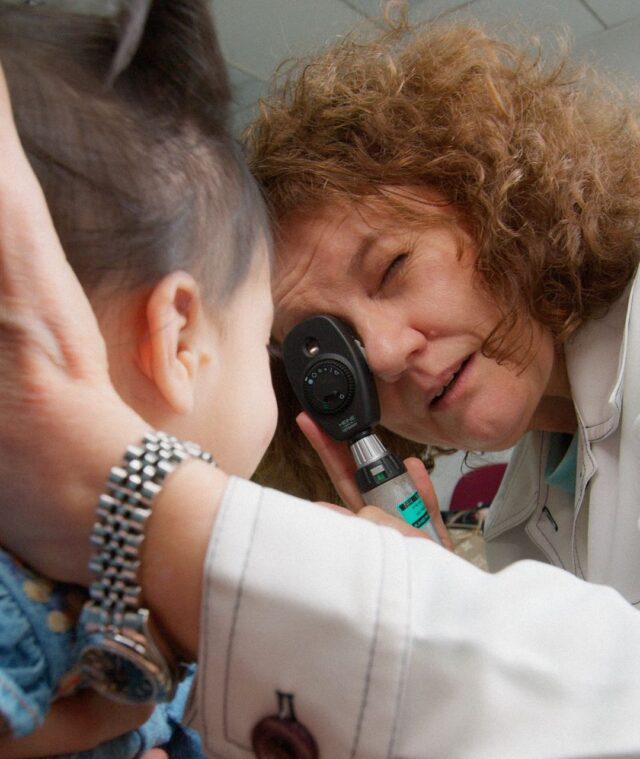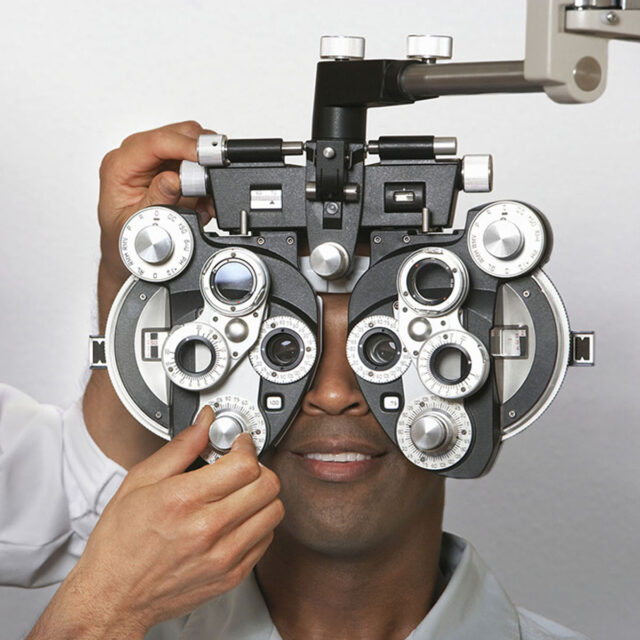Prevention is key to eye health. Our team of highly experienced eye health specialists at Gulf Family Clinic consistently emphasise the importance of early detection with every patient because most eye conditions progress silently, causing irreversible damage before symptoms are noticeable.
Come 20 – 26 October, our clinic will pay particular attention to eye inflammation as Prevent Blindness announces its fifth annual Inflammatory Eye Disease (IED) Awareness Week. IED Awareness Week, organised by Prevent Blindness, focuses on educating people about inflammatory eye conditions. The leading volunteer eye health and safety organisation will offer free resources, such as social media graphics, fact sheets and expert videos on IED.
As part of our IED Awareness Week observance, we’ve come up with this guide to help you recognise symptoms, understand the causes and learn about treatment options for eye inflammation.
In Focus
- The annual Inflammatory Eye Disease (IED) Awareness Week educates people about inflammatory eye conditions.
- IED can develop due to allergies, infection, injuries, irritation, trauma or autoimmune diseases.
- Uveitis is the most common type of IED, developing when the eye’s middle layer becomes inflamed.
- Autoimmune diseases like Graves’ disease, multiple sclerosis and juvenile idiopathic arthritis are some of the diseases that can cause eye inflammation.
- IED treatment depends on the diagnosis, but most will involve eye drops, medication, ointments, injections and sometimes surgery.
Table of Contents
What Is Inflammatory Eye Disease?
Inflammatory eye disease is a common condition that can affect anyone at any age. It covers a wide spectrum of conditions related to eye inflammation.
What are the causes and risk factors for IED? Eye inflammation can occur in response to allergies, infection, injuries, irritation or autoimmune diseases. Trauma to the eye, eyelids or surrounding tissues may also cause IED.
Risk factors typically include family history and unhealthy habits (i.e., smoking tobacco can be associated with eye inflammation).
As we’ve found with countless cases in our clinic, early detection and appropriate treatment can relieve symptoms and prevent the threat to eyesight.
Can inflammatory eye disease cause permanent vision loss? In severe inflammatory eye conditions, IED can lead to permanent vision loss. The potential threat to eyesight depends on the diagnosed type of IED.
What Are the Types of Inflammatory Eye Conditions?
The eye has multiple layers of tissue that surround a central gel-filled cavity: retina (innermost layer), sclera (outermost layer) and uveal tract (middle layer). IED comes in different types, each affecting the various parts of the eye in distinct ways.
Uveitis
The uveal tract is where eye inflammation typically occurs, making uveitis the most common IED. Uveitis is further classified according to which part is inflamed:
- Anterior (also called iritis or iridocyclitis) – can be associated with juvenile idiopathic arthritis and rare conditions, like Posner-Schlossman syndrome.
- Intermediate – linked to systemic diseases, such as multiple sclerosis (MS), tuberculosis or Lyme disease.
- Posterior – can be caused by viral retinitis and toxoplasmosis, or linked to systemic diseases.
- Panuveitis – linked to systemic diseases, such as Behcet’s disease or sarcoidosis.
Uveitis requires urgent treatment because it can potentially cause permanent vision loss.
Keratitis
Keratitis is the inflammation of the cornea. Also called corneal ulcer, keratitis can be classified as infectious and non-infectious.
If bacteria, fungi, viruses or parasites cause the inflammation, an eye exam will confirm it’s infectious. If the inflammation is due to improper use of contact lenses, dry eye or an injury, it’s non-infectious.
Keratitis is treatable, but it is a common cause of corneal blindness.
Conjunctivitis
More commonly called ‘pink eye’, conjunctivitis is an inflammation of the conjunctiva. The cause will depend on the type of conjunctivitis.
- Allergic – seasonal allergies and chronic presence of a foreign body in the eye can cause allergic conjunctivitis.
- Infectious – can occur due to an infection (bacterial), viruses (e.g., linked to the common cold, or cold sores’ ) or severe neonatal bacterial infection (ophthalmia neonatorum), and fungal infection.
- Chemical – irritants, such as chlorine in swimming pools, air pollution and noxious environmental chemicals can cause chemical conjunctivitis.
CONJUNCTIVITIS TREATMENT IN DUBAI
Early intervention starts with a diagnostic screening in our Dubai clinic using advanced technologies and techniques.
Thyroid Eye Disease
Thyroid eye disease (TED) is also called Graves’ ophthalmopathy or Graves’ Eye Disease. It’s an autoimmune disease that occurs when the immune system causes inflammation and swelling. TED is often associated with Graves’ disease, which is a thyroid condition.
What Autoimmune Diseases Cause Eye Inflammation?
Other than Graves’ disease, autoimmune diseases like MS, rheumatoid arthritis, systemic lupus erythematosus, ankylosing spondylitis and juvenile idiopathic arthritis can cause eye inflammation diseases.
Autoimmune diseases occur when the immune system mistakenly attacks healthy cells in the body, which includes the eyes.
In our practice, we typically see symptoms of eye inflammation due to autoimmune disorders in the following ways:
- Dry or red eyes
- Pain
- Visual changes (or vision loss)
- Light sensitivity (photophobia)
- Itchy eyes (ocular pruritus)
How often should people with autoimmune conditions get eye checks?
Autoimmune diseases that cause eye inflammation require immediate attention, Complications can affect eye health. Depending on the patient’s medical history and lifestyle, frequent eye exams may be necessary to monitor asymptomatic cases.
What Are the Early Signs and Symptoms to Observe?
The early signs and symptoms of IED will depend on the type of inflammation.
With anterior uveitis, a patient can experience pain, redness, blurred vision and light sensitivity. Some signs may include pupil shape changes and the accumulation of white liquid at the bottom of the eye or in a ring around the iris.
With allergic conjunctivitis, some symptoms may include clear, watery discharge, mild redness and itching. Patients who have bacterial conjunctivitis may experience mild pain with moderate redness. In some severe cases, we’ve observed yellow or green discharge that can make the eyelids red and swollen. Seborrhoeic Blepharitis due to Meibomian Gland Dysfunction and consequent dry eyes can be sticky and gritty with discharge on wakeup.
When you’ve experienced unusual pain, redness, or discharge in the eye, we recommend coming in for an eye exam.
How Are Eye Inflammation Diseases Diagnosed?
Eye health specialists diagnose inflammatory eye conditions through a comprehensive eye exam. The clinical exam will include a physical evaluation to check your vision and the external structure of your eyes. You need to do a visual acuity test to gauge the effect on vision.
Your eye specialist in Dubai will also look into your medical and family history, and ask about any risk factors. For instance, the doctor will ask if you’ve had any injury or diseases lately.
Supplemental testing may include the following:
- Tonometry
- Optical coherence tomography
- Blood tests
- Imaging scans
- Cultures or smears of tissue
- Analysis of aqueous or vitreous fluid
What Are the Current Treatment Options and Therapies for IED?
The options for treating inflammatory eye disease vary depending on the diagnosis. Most treatments involve prescription anti-inflammatory eye drops and medication, ointments, or injections per individual needs. In some cases, surgery may be necessary.
Your doctor may also prescribe a maintenance therapy to prevent recurrence, especially for infectious conjunctivitis.
Some preventive measures for inflammatory eye conditions include:
- Washing your hands frequently
- Never touching or rubbing your eyes with unclean hands
- Using sunglasses or any protective eyewear during outdoor activities
- Resting your eyes and taking screen breaks
- Following a good diet that supports eye health
A regular eye exam is one of the best preventive measures for eye inflammation. A comprehensive eye exam detects eye issues early on, ensuring the appropriate treatment.
Protect Your Eyes and Vision
We understand how overwhelming it is to learn that vision loss is probable with an underlying condition, infection or injury to the eye. With early diagnosis and appropriate treatment, you can prevent major eye health issues and the potential for vision loss.
Join us in observing Inflammatory Eye Disease Awareness Week in October by arranging an exam at our eye clinic in Dubai. Protect your eyes and vision, protect your future.









